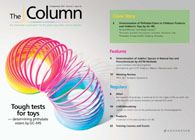Ethanol emissions
A technique has been developed that allows scientists to track urban atmospheric plumes from manmade biofuels using a unique isotopic signature found in vehicle emissions.
A technique has been developed that allows scientists to track urban atmospheric plumes from manmade biofuels using a unique isotopic signature found in vehicle emissions.
Ethanol is used in making biofuels and as these fuels become more widely used, interest in their influence on air quality is increasing. When biofuels are burnt the remaining ethanol emitted as exhaust has a much higher 13C to 12C ratio than the ethanol naturally emitted by tropical plants. A study published in Environmental Science & Technology has suggested that this signature can be used to track plumes as they drift away from urban areas.1
The researchers collected and analysed air from downtown Miami, Florida, USA, and the nearby Everglades National Park. The components of the air samples from the two locations were first separated using gas chromatography, before the abundance of each carbon isotope was measured via a mass spectrometer. The study found that 75% of ethanol in Miami’s urban air came from manmade biofuels, while the majority of ethanol in the Everglades air was emitted from plants, even though a small quantity of city pollution from a nearby road floats into the park.
It is estimated that plants currently release three times as much ethanol as manmade sources but the authors of the study warn that as the amount of ethanol used in fuels increases this should change.
1. B.M. Giebel, P.K. Swart and D.D. Riemer, Environ. Sci. Technol., 45(15), 6661–6669 (2011).
This story originally appeared in The Column. Click here to view that issue.
Measuring Vitamin K1 Concentrations in Dogs with Chronic Enteropathy Using LC–MS/MS
May 14th 2025A joint study between the University of Tennessee (Knoxville, Tennessee) and the University of Pennsylvania School of Veterinary Medicine (Philadelphia, Pennsylvania) compared directly measured vitamin K1 (vitK1) concentrations in healthy dogs and dogs with chronic enteropathy (CE) using liquid chromatography tandem mass spectrometry (LC–MS/MS); they also investigated whether supplementation of vitK1 in dogs with CE would significantly increase vitK1 concentrations.
HPLC 2025 Preview: Fundamentally Speaking (Part 2)
May 14th 2025Michael Lämmerhofer from the Institute of Pharmaceutical Sciences, University of Tübingen, Germany, spoke to JFK Huber Lecture Award winner of 2024 Torgny Fornstedt, professor in analytical chemistry and leader of the Fundamental Separation Science Group, Karlstad University, Sweden, about his pioneering work in high performance liquid chromatography (HPLC) with a focus on fundamentals, ion-pair chromatography, and oligonucleotide applications.

.png&w=3840&q=75)

.png&w=3840&q=75)



.png&w=3840&q=75)



.png&w=3840&q=75)










